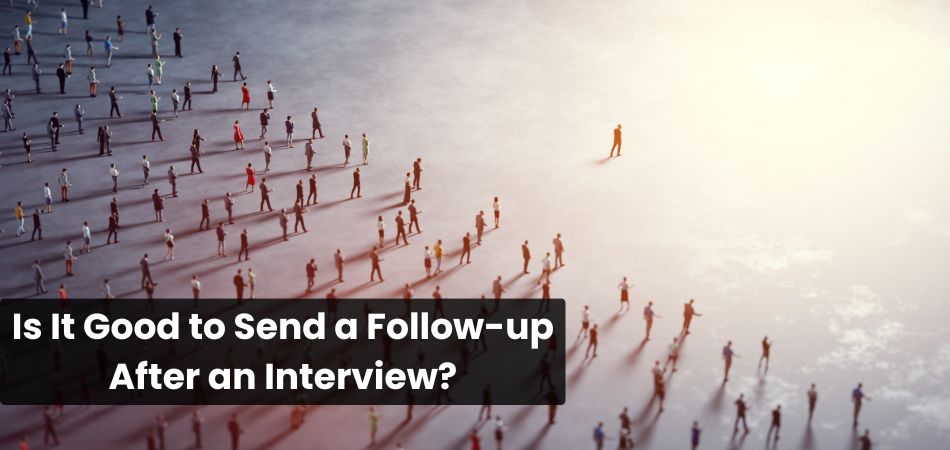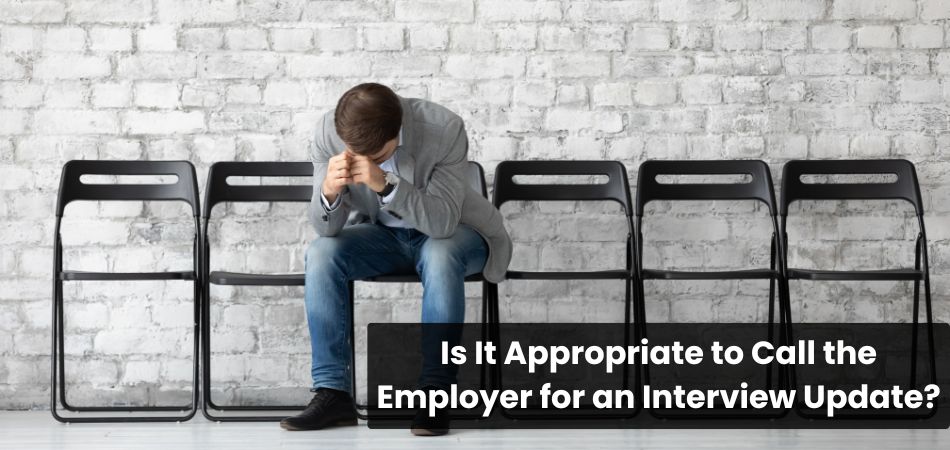Nailing an interview is just the first step toward landing your dream job, but what comes next can be just as important. In that case, knowing how to follow up after an interview can set you apart from other candidates and leave a lasting impression on potential employers.
To follow up after an interview, you should send a personalized thank-you email within 24-48 hours, referencing key points from the discussion. Maintain professionalism, highlight achievements, and respect boundaries in timing and frequency.
Following this post, we’ll explore practical tips and examples to help you navigate the post-interview process with confidence and finesse. Would you like to turn that interview into a job offer? Let’s begin!
Is It Good to Send a Follow-up After an Interview?
You should follow up after an interview in a strategic manner, not just as a polite gesture. It demonstrates your interest, keeps you top of mind, and showcases professionalism. One important part of this process is sending a thank-you email to express your gratitude. Here’s an explanation of why sending a thank-you email can be beneficial and how to approach it effectively.

Shows Gratitude and Professionalism
Sending a follow-up email is a chance to thank the interviewer for their time and effort. It highlights your appreciation for the opportunity, leaving a positive impression. This simple act can differentiate you from other candidates who don’t take the extra step.
Reinforces Your Interest in the Role
A follow-up reaffirms your enthusiasm for the position and the company. Employers value candidates who show genuine interest and dedication. By restating why you’re a good fit, you strengthen your case for consideration.
Clarifies Any Unresolved Questions
If there were any questions you couldn’t fully address during the interview, a follow-up gives you a second chance. It’s also an opportunity to elaborate on your skills or share additional details. This proactive approach demonstrates initiative and problem-solving skills.
Keeps You on the Employer’s Radar
Recruiters juggle multiple candidates, and following up ensures you stay memorable. It reminds them of your qualifications and eagerness to contribute. A well-timed message can even expedite decision-making on their end.
Demonstrates Communication Skills
Effective communication is a valued trait in any workplace, and a thoughtful follow-up showcases yours. It reflects your ability to engage professionally and respect deadlines. These qualities can leave a lasting impression, even if you’re not immediately selected.
When Is the Right Time to Follow Up After an Interview?
Timing your follow-up after an interview is crucial to maintaining professionalism without appearing impatient. Generally, the best time to follow up is within 24-48 hours after the interview. This timeframe strikes the perfect balance, allowing you to express gratitude while the conversation is still fresh in the interviewer’s mind.
For subsequent follow-ups, respect the employer’s timeline. If they mentioned a decision date during the interview, wait a few days beyond that before reaching out. If no timeline was provided, consider sending a polite inquiry after 7-10 business days. This approach shows patience while still demonstrating interest and initiative.
When following up, choose business hours to send your message, ideally early in the day or mid-morning. This timing increases the likelihood of your email being noticed and responded to promptly. Avoid weekends or late evenings, as these may come across as intrusive or unprofessional. With thoughtful timing, you can leave a positive impression without overstepping boundaries.
How to Follow Up After an Interview?
An interview follow-up isn’t just about sending a thank-you email. It’s an opportunity to showcase your communication skills, address any lingering doubts, and reinforce your interest in the role. Here’s how to navigate the follow-up process step-by-step to leave a lasting impression.

1. Prepare Before the Interview Ends
Set yourself up for a successful follow-up by asking about the next steps before the interview concludes. Inquire politely about the decision-making timeline or the best way to reach out. This information will guide your follow-up approach and demonstrate your eagerness. It also eliminates guesswork, making your follow-up more targeted.
2. Be Specific with Your Follow-Up Message
Avoid generic emails by referencing specific points discussed during the interview. Mention any key takeaways or moments that resonated with you. This personalization shows attentiveness and a genuine connection to the conversation. A unique follow-up makes your message memorable.
3. Highlight New Achievements
If you’ve completed a relevant project or earned a certification since the interview, include it in your follow-up. Showing growth and proactive learning adds value to your candidacy. Keep it concise, focusing on how the new development aligns with the role. This approach can make your application even more compelling.
4. Use Multiple Channels Strategically
While email is the most common method, consider other channels if appropriate, such as LinkedIn. A polite message through LinkedIn can help maintain a professional relationship. Ensure your tone is consistent and professional across all platforms. Diversifying communication can help you stand out in a crowded field.
5. Respect Boundaries in Timing and Frequency
Avoid excessive follow-ups that could appear desperate or intrusive. One follow-up after the interview and another after the decision date are typically sufficient. If there’s no response after your second attempt, it’s best to move on. Respect for the employer’s time reflects well on your professionalism.
6. Follow Up After Rejection
Even if you’re not selected, a follow-up can leave a positive impression for future opportunities. Thank the interviewer for considering your application and expressing interest in future roles. This gesture shows maturity, resilience, and a long-term mindset. You may be considered for other positions down the line.
7. Keep Your Tone Professional and Polite
Regardless of the outcome or delays in response, maintain a polite and professional tone. Avoid sounding pushy or overly casual in your language. This shows emotional intelligence and adaptability, qualities employers value. A calm, respectful approach strengthens your overall impression.
Should You Follow Up More Than Once?
Following up more than once after an interview can be appropriate if done thoughtfully and strategically. A single follow-up is usually sufficient to express gratitude and interest, but a second follow-up can be helpful in specific scenarios, such as when the employer has not responded within the expected timeline. This ensures you stay on their radar without overstepping professional boundaries.
If you decide to send a second follow-up, provide a valid reason to reconnect. For example, you can mention new achievements, clarify a point from the interview, or politely inquire about the status of your application. Avoid repeating the same message; instead, offer value by demonstrating your continued enthusiasm and alignment with the role. Each communication should add something new to the conversation.
However, knowing when to stop is equally important. If there’s no response after two follow-ups, it’s best to respect the employer’s decision. Continuing to send messages may come across as overly persistent and harm your professional image.
Is It Appropriate to Call the Employer for an Interview Update?
Calling the employer for an interview update can be a bold move, but it’s not always the best approach. While it shows initiative, timing and tone are crucial to ensure it’s received positively. Here’s how to deal with this situation effectively with professionalism and respect.

Assess the Situation First
Before picking up the phone, consider whether calling is the best option. If the employer explicitly stated a preferred communication method or timeline, respect those guidelines. Only call if other follow-up methods, like email, have gone unanswered, and enough time has passed.
Choose the Right Time to Call
Timing is everything when making a follow-up call. Avoid early mornings, late evenings, or weekends, as these may inconvenience the employer. Mid-morning or early afternoon on a weekday is usually a safe choice.
Prepare Your Message in Advance
Have a clear and concise reason for your call to avoid wasting the employer’s time. Write down key points you want to address, including your name, the role you applied for, and a polite inquiry about the status. This preparation ensures you sound confident and professional.
Keep the Conversation Brief
Respect the employer’s time by keeping your call short and to the point. Express your gratitude for the opportunity and ask politely for an update. Avoid pressuring the employer for a decision; instead, focus on leaving a positive impression.
Have a Backup Plan if You Can’t Reach Them
If your call goes unanswered, leave a polite voicemail with your contact information. Reiterate your email follow-up for a consistent message across platforms. Be patient and wait for their response before making another attempt to contact them.
Common Mistakes to Avoid When Following Up After an Interview
Following up after an interview is a critical part of the hiring process, but it’s easy to misstep. Avoiding common mistakes ensures your communication remains professional and effective. Here are some pitfalls to watch out for and how to steer clear of them.
- Failing to Personalize Your Message: Sending a generic follow-up email can make you blend in with other candidates. Reference specific details from your interview to show genuine interest and attentiveness.
- Using an Overly Casual Tone: Being too casual in your language can come across as unprofessional. Always maintain a polite and formal tone to align with workplace expectations.
- Following Up Too Frequently: Bombarding the employer with repeated messages can feel intrusive and pushy. Stick to one or two well-timed follow-ups and respect their timeline.
- Omitting Contact Details in Your Message: Forgetting to include your phone number or email in your follow-up can cause unnecessary delays. Make it easy for the employer to reach you if they want to respond.
- Focusing Solely on Yourself: Your follow-up should emphasize what you can contribute to the company, not just your desire for the job. Highlight how your skills align with their needs to keep the focus on value.
- Neglecting Spelling and Grammar: Typos and errors can undermine your professionalism and attention to detail. Proofread your message carefully before hitting send to leave a strong impression.
FAQs About Following Up After an Interview
Following up after an interview can feel tricky, especially if you’re unsure of the proper etiquette. To help you get through this process, here are answers to some of the most frequently asked questions. With these tips, you can follow up confidently and leave a strong, professional impression.
1. How Long Should I Wait Before Following Up?
It’s generally best to follow up within 24-48 hours after the interview. This shows appreciation while the discussion is still fresh in the interviewer’s mind. For subsequent follow-ups, wait 7-10 business days unless the employer specifies a different timeline.
2. What Should I Do If I Don’t Hear Back?
If you don’t receive a response, consider sending a polite second follow-up email. Restate your interest and inquire about any updates regarding the hiring process. If there’s still no reply, it’s okay to move on and explore other opportunities.
3. Is It Okay to Reach Out Directly to the Hiring Manager?
Reaching out directly can be appropriate if done professionally and respectfully. Ensure your message is concise, courteous, and relevant to the role. Avoid being overly persistent, as this can harm your chances.
4. Can I Follow Up If I Was Told I Didn’t Get the Job?
Yes, following up after a rejection can leave a positive impression. Thank the interviewer for their time and express interest in future opportunities. This demonstrates maturity and keeps the door open for other roles within the company.
5. Should I Call or Email to Follow Up?
Email is typically the preferred method for following up after an interview. It’s professional, non-intrusive, and allows the recipient to respond at their convenience. However, if the employer specifically invites a phone call, ensure it’s brief and courteous.
Final Words
Following up after an interview is a crucial step in the job search process that can make a lasting impression on potential employers. It demonstrates professionalism, enthusiasm, and your ability to communicate effectively.
In that case, knowing how to follow up after an interview helps you stand out from other candidates and shows that you are proactive and detail-oriented. A well-timed, thoughtful follow-up can keep you on the employer’s radar and even expedite decision-making.
By avoiding common mistakes and staying respectful, you can maximize your chances of turning an interview into a job offer. Take the time to follow up the right way!
